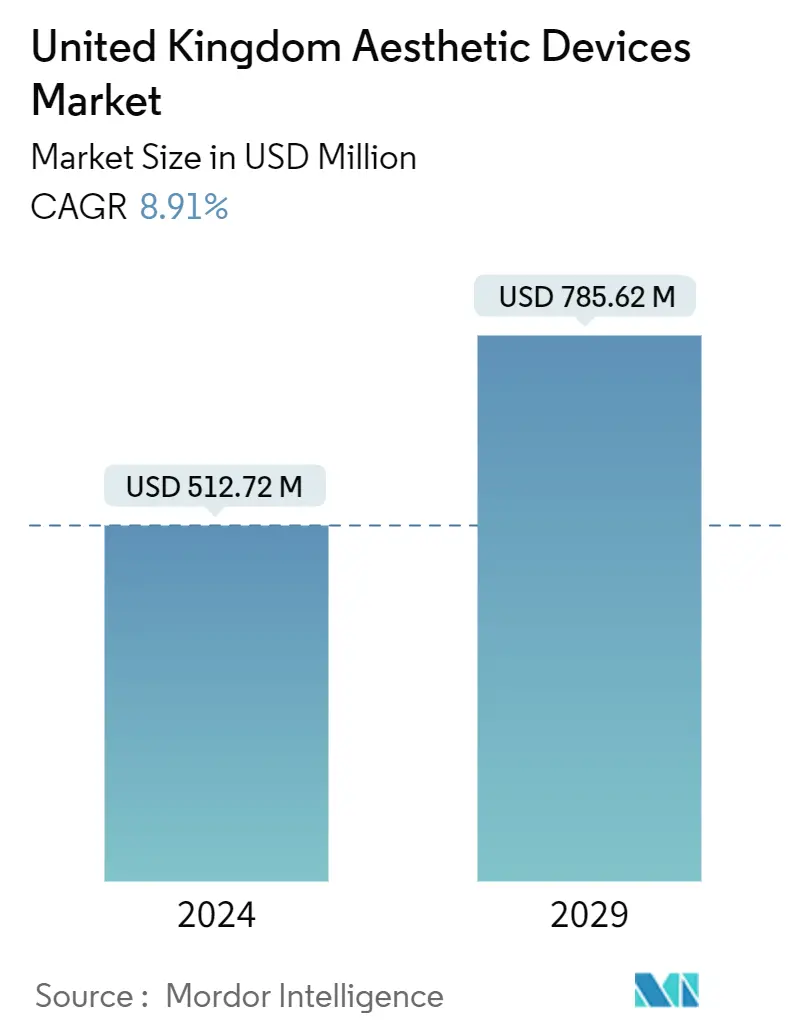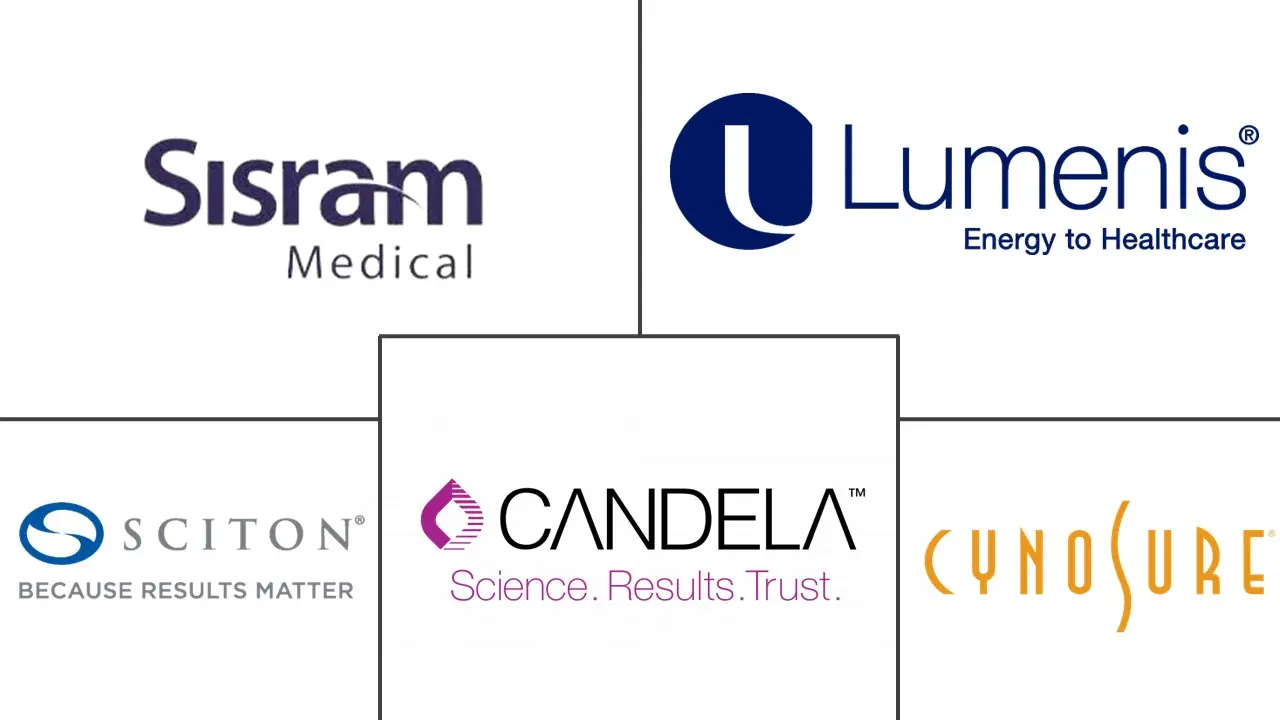Market Size of United Kingdom Aesthetic Devices Industry

| Study Period | 2019 - 2029 |
| Base Year For Estimation | 2023 |
| Market Size (2024) | USD 512.72 Million |
| Market Size (2029) | USD 785.62 Million |
| CAGR (2024 - 2029) | 8.91 % |
| Market Concentration | High |
Major Players
*Disclaimer: Major Players sorted in no particular order |
United Kingdom Aesthetic Devices Market Analysis
The United Kingdom Aesthetic Devices Market size is estimated at USD 512.72 million in 2024, and is expected to reach USD 785.62 million by 2029, growing at a CAGR of 8.91% during the forecast period (2024-2029).
The United Kingdom's Medical Aesthetics Market is undergoing notable growth, driven by key macroeconomic factors and consumer trends. The rising demand for non-invasive cosmetic procedures, coupled with advancements in Aesthetic Technology and shifting demographics, forms the backbone of this expansion. Several influential trends, including the increasing obese population, heightened awareness about aesthetic treatments, the rapidly aging population, and continuous technological progress, are fueling development in the Aesthetic Market. These drivers work synergistically, creating a strong foundation for sustained growth. As UK consumers become increasingly health-conscious and appearance-focused, the demand for Aesthetic Devices continues to accelerate, encouraging innovation and expanding the market.
Increasing Obese Population: Obesity is emerging as a critical factor in the UK's Aesthetic Devices Market growth. According to the National Health Service's Health Survey for England, 26% of adults in England are obese, with 69% of men and 59% of women classified as overweight or obese. Such high obesity rates are boosting demand for Body Contouring Devices and cellulite reduction procedures. The Office for Health Improvement and Disparities reports that over 25% of UK adults are affected by obesity, a trend extending beyond older adults, with 12% of 18-24 year-olds and 21.8% of 25-34 year-olds also obese. As obesity becomes prevalent across all age groups, the demand for Aesthetic Devices, particularly for weight management and body sculpting, is projected to rise.
Growing Awareness about Aesthetic Procedures: A significant rise in awareness about aesthetic procedures has fueled the UK's Aesthetic Devices Market. The British Association of Aesthetic Plastic Surgeons (BAAPS) reports Breast Augmentation Statistics indicating that over 15,000 cosmetic procedures are performed annually, with breast augmentation leading the way at 4,000 procedures. The surge in demand for aesthetic treatments is partly driven by the pandemic's rise in video conferencing, making people more conscious of their appearance. Additionally, the UK boasts approximately 600 aesthetic surgeons, representing 1.4% of the global total. During the COVID-19 pandemic, The Guardian noted a 70% increase in requests for video consultations for cosmetic procedures. This growing interest is expected to sustain the market's upward trajectory.
Rapidly Increasing Aging Population: Demographic shifts, particularly the aging population, are another key driver in the UK's Aesthetic Devices Market. According to the Office for National Statistics, the UK's population is expected to exceed 69.6 million by 2029, with one in four individuals aged 65 and older by 2050. This shift is driving demand for anti-aging Skin Rejuvenation Devices and treatments aimed at addressing wrinkles, skin laxity, and age spots. The Health Foundation projects that within the next 25 years, the number of individuals aged 85 and above will double to 2.6 million, further expanding the market for age-related aesthetic procedures.
Rapid Technological Advancements: The UK's Aesthetic Devices Market is heavily influenced by continuous innovations in Aesthetic Technology that enhance the effectiveness, safety, and accessibility of aesthetic procedures. Notable developments, such as Emsculpt's HIFEM technology for muscle building and Lumenis's Splendor X Aesthetic Laser for hair removal, underscore the sector's rapid pace of innovation. Companies like BTL Group and Lumenis are introducing cutting-edge technologies, including the Exilis Ultra360 and Splendor X, which offer enhanced body contouring, skin tightening, and hair removal solutions. These advancements are reshaping patient expectations, broadening treatment options, and contributing to market growth.
These interconnected drivers—changing demographics, growing awareness, technological advances, and health trends—are creating a robust foundation for the continued growth of the UK Aesthetics Industry. As consumers seek more advanced treatments with minimal downtime, and companies continue to push technological boundaries, the Aesthetic Market is expected to see sustained growth in the coming years.
United Kingdom Aesthetic Devices Industry Segmentation
As per the scope of the report, medical aesthetic devices refer to medical devices that are used for various cosmetic procedures. This includes plastic surgery, unwanted hair removal, excess fat removal, anti-aging, aesthetic implants, skin tightening, etc., which are used for beautification, correction, and improvement of the body.
The UK aesthetic devices market is segmented by type of device, application, and end user. By type of device, the market is segmented into energy-based aesthetic devices non-energy-based aesthetic devices and other aesthetic devices. By energy-based aesthetic devices, the market is segmented into laser-based aesthetic devices, radiofrequency (RF)-based aesthetic devices, light-based aesthetic devices, and ultrasound aesthetic devices. By non-energy-based aesthetic devices, the market is segmented into botulinum toxin, dermal fillers, and aesthetic threads, chemical peels, microdermabrasion, implants. By implants, the market is segmented into facial implants, breast implants, and other implants. By application, the market is segmented into skin resurfacing and tightening, body contouring and cellulite reduction, hair removal, tattoo removal, breast augmentation, and other applications. By end user, the market is segmented into hospitals, clinics, and home settings. The report offers the value (USD) for all the above segments.
| By Type of Device | ||||||||||||
| ||||||||||||
|
| By Application | |
| Skin Resurfacing and Tightening | |
| Body Contouring and Cellulite Reduction | |
| Hair Removal | |
| Tattoo Removal | |
| Breast Augmentation | |
| Other Applications |
| By End User | |
| Hospital | |
| Clinics | |
| Home Settings |
United Kingdom Aesthetic Devices Market Size Summary
The UK medical aesthetic devices market is poised for significant growth over the forecast period, driven by a resurgence in demand following the COVID-19 pandemic's impact on the industry. The market is experiencing a recovery as beauty clinics and practitioners resume operations, with a notable return of customers seeking cosmetic procedures. Factors such as an increasing geriatric and obese population, heightened awareness of aesthetic procedures, and technological advancements are contributing to the market's expansion. The rising prevalence of obesity is particularly influential, as it correlates with a higher demand for procedures like fat reduction and liposuction. The introduction of advanced aesthetic devices by companies such as BTL Group and Lumenis further supports market growth, despite potential challenges from stringent regulations and reimbursement issues.
The market is characterized by a competitive landscape with several key players vying for market share. The establishment of new facilities offering hair removal procedures and the launch of innovative devices are expected to drive segmental growth. The breast augmentation segment, in particular, is witnessing a rapid increase in procedures, fueled by women's preferences for enhanced aesthetic appeal. Major players are focusing on product development and commercialization to capture market opportunities, with international companies entering the UK market with advanced technologies. This competitive environment is leading to strategic partnerships and acquisitions, further shaping the market dynamics. Overall, the UK medical aesthetic devices market is set to experience robust growth, supported by technological advancements and increasing consumer demand.
United Kingdom Aesthetic Devices Market Size - Table of Contents
-
1. MARKET DYNAMICS
-
1.1 Market Overview
-
1.2 Market Drivers
-
1.2.1 Increasing Obese Population
-
1.2.2 Increasing Awareness about Aesthetic Procedures
-
1.2.3 Rapidly Increasing Aging Population
-
1.2.4 Rapid Technological Advancements
-
-
1.3 Market Restraints
-
1.3.1 Stringent Safety Regulations for Aesthetic Procedures
-
1.3.2 Reimbursement Issues
-
-
1.4 Porter's Five Forces Analysis
-
1.4.1 Threat of New Entrants
-
1.4.2 Bargaining Power of Buyers/Consumers
-
1.4.3 Bargaining Power of Suppliers
-
1.4.4 Threat of Substitute Products
-
1.4.5 Intensity of Competitive Rivalry
-
-
-
2. MARKET SEGMENTATION (Market Size by Value - in USD)
-
2.1 By Type of Device
-
2.1.1 Energy-based Aesthetic Device
-
2.1.1.1 Laser-based Aesthetic Device
-
2.1.1.2 Radiofrequency (RF)-based Aesthetic Device
-
2.1.1.3 Light-based Aesthetic Device
-
2.1.1.4 Ultrasound Aesthetic Device
-
-
2.1.2 Non-energy Based Aesthetic Device
-
2.1.2.1 Botulinum Toxin
-
2.1.2.2 Dermal Fillers and Aesthetic Threads
-
2.1.2.3 Chemical Peels
-
2.1.2.4 Microdermabrasion
-
2.1.2.5 Implants
-
2.1.2.5.1 Facial Implants
-
2.1.2.5.2 Breast Implants
-
2.1.2.5.3 Other Implants
-
-
2.1.2.6 Other Aesthetic devices
-
-
-
2.2 By Application
-
2.2.1 Skin Resurfacing and Tightening
-
2.2.2 Body Contouring and Cellulite Reduction
-
2.2.3 Hair Removal
-
2.2.4 Tattoo Removal
-
2.2.5 Breast Augmentation
-
2.2.6 Other Applications
-
-
2.3 By End User
-
2.3.1 Hospital
-
2.3.2 Clinics
-
2.3.3 Home Settings
-
-
United Kingdom Aesthetic Devices Market Size FAQs
How big is the United Kingdom Aesthetic Devices Market?
The United Kingdom Aesthetic Devices Market size is expected to reach USD 512.72 million in 2024 and grow at a CAGR of 8.91% to reach USD 785.62 million by 2029.
What is the current United Kingdom Aesthetic Devices Market size?
In 2024, the United Kingdom Aesthetic Devices Market size is expected to reach USD 512.72 million.

